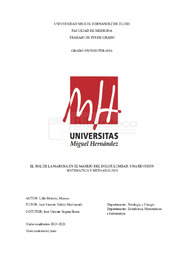Please use this identifier to cite or link to this item:
https://hdl.handle.net/11000/37526Full metadata record
| DC Field | Value | Language |
|---|---|---|
| dc.contributor.advisor | Toledo Marhuenda, José Vicente | - |
| dc.contributor.advisor | Segura Heras, José Vicente | - |
| dc.contributor.author | Lillo Mottola, Marcos | - |
| dc.contributor.other | Departamentos de la UMH::Patología y Cirugía | es_ES |
| dc.contributor.other | Departamentos de la UMH::Estadística, Matemáticas e Informática | es_ES |
| dc.date.accessioned | 2025-09-24T09:39:52Z | - |
| dc.date.available | 2025-09-24T09:39:52Z | - |
| dc.date.created | 2025-05-28 | - |
| dc.identifier.uri | https://hdl.handle.net/11000/37526 | - |
| dc.description.abstract | Introducción: El dolor lumbar crónico no específico (DLCNE) afecta a 619 millones de casos a escala mundial y genera altos costes sanitarios. Ante la ausencia de consenso sobre el ejercicio óptimo, la marcha se describe como una intervención aeróbica, económica y accesible. Objetivos: Determinar la efectividad de los programas de marcha sobre la intensidad de dolor y la discapacidad en adultos con DLCNE. Pudiendo ser realizados de forma aislada o añadidos a un tratamiento convencional/ejercicio terapéutico de fuerza/estabilidad. Metodología: Revisión sistemática y metaanálisis (COIR TFG.GFI.JVTM.MLM.241130). Se buscaron ECA en PubMed y EMBASE (2015-2025). En total, se incluyeron 12 ECA (n = 1,507; 74 % mujeres; edad 49.3 ± 13.3 años). El riesgo de sesgo se evaluó con RoB 2 y la calidad con PEDro (media 6 ± 1.1). Resultados: El metaanálisis no mostró diferencias significativas entre la marcha (sola o combinada) y los programas de fuerza ni en dolor ni en discapacidad hasta 12 semanas. Todos los ensayos presentaron tamaños del efecto muy grandes (SMD > 1) y heterogeneidad elevada (I² > 70 %). Las intensidades de ejercicio moderadas-altas (≥ 65-85 % FCmáx) presentaron tamaños del efecto superiores respecto a las intervenciones de menor intensidad. Conclusiones: La marcha, sola o añadida al ejercicio convencional, es una alternativa económica que ofrece mejoras analgésicas y funcionales comparables al entrenamiento de fuerza. Además, podría reducir las recaídas cuando se dosifica adecuadamente, lo que apoya su inclusión como opción de primera línea. | es_ES |
| dc.description.abstract | Introduction: Chronic non-specific low back pain (CNSLBP) affects 619 million people worldwide and entails substantial healthcare costs. In the absence of consensus on the optimal exercise modality, walking is described as an aerobic, inexpensive and accessible intervention. Objectives: To determine the effectiveness of walking programs on pain intensity and disability in adults with CNSLBP, either performed alone or added to conventional treatment/strength- or stability-oriented therapeutic exercise. Methods: Systematic review and meta-analysis (COIR TFG.GFI.JVTM.MLM.241130). Randomized controlled trials (RCTs) listed in PubMed and EMBASE (2015–2025) were searched. Twelve RCTs were included (n = 1 507; 74 % women; mean age 49.3 ± 13.3 years). Risk of bias was assessed with RoB 2 and methodological quality with the PEDro scale (mean 6 ± 1.1). Results: The meta-analysis found no significant differences between walking (alone or in combination) and strength-training programs for either pain or disability up to 12 weeks. All trials reported very large effect sizes (SMD > 1) and substantial heterogeneity (I² > 70%). Exercise performed at moderate-to-high intensities (≥ 65–85 % HRmax) produced larger effect sizes than lower-intensity interventions. Conclusions: Walking, whether delivered as a stand-alone intervention or added to conventional exercise, is a low-cost alternative that provides analgesic and functional improvements comparable to strength training. When properly dozed, it may also reduce relapse rates, supporting its inclusion as a first-line option. | es_ES |
| dc.format | application/pdf | es_ES |
| dc.format.extent | 51 | es_ES |
| dc.language.iso | spa | es_ES |
| dc.publisher | Universidad Miguel Hernández | es_ES |
| dc.rights | info:eu-repo/semantics/openAccess | es_ES |
| dc.rights | Attribution-NonCommercial-NoDerivatives 4.0 Internacional | * |
| dc.rights.uri | http://creativecommons.org/licenses/by-nc-nd/4.0/ | * |
| dc.subject | Dolor lumbar crónico | es_ES |
| dc.subject | marcha | es_ES |
| dc.subject | fisioterapia | es_ES |
| dc.subject | ejercicio terapéutico | es_ES |
| dc.subject | ejercicio aeróbico | es_ES |
| dc.subject.other | CDU::6 - Ciencias aplicadas | es_ES |
| dc.title | El rol de la marcha en el manejo del dolor lumbar: una revisión sistemática y metaanálisis. | es_ES |
| dc.type | info:eu-repo/semantics/bachelorThesis | es_ES |

View/Open:
TFG ENTREGA MARCOS LILLO MOTTOLA.pdf
4,27 MB
Adobe PDF
Share:
.png)
